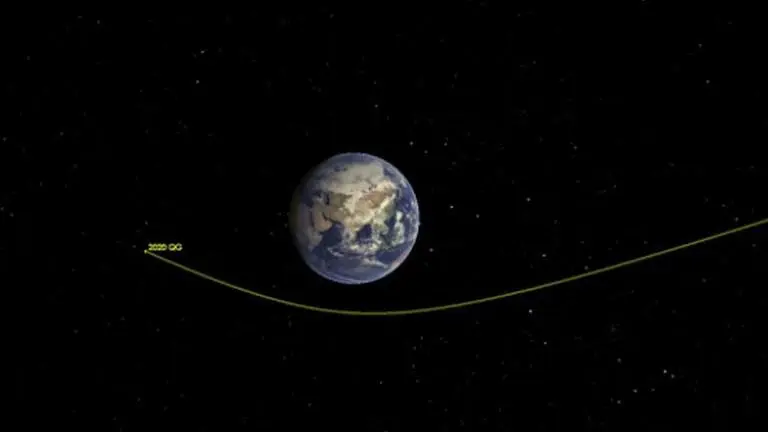Updated 19 August 2020 at 14:09 IST
Asteroid 2020 QG about the size of SUV flew 'closest-ever' to Earth: NASA
Asteroid 2020 QG, which is extremely small in size, flew roughly 10 to 20 feet (3 to 6 meters) across and might have transformed into a “fireball”, NASA said.
- Science News
- 3 min read

On August 16, a tiny asteroid, about the size of an SUV flew the closest to the earth and was detected by NASA funded survey, the NASA Jet Propulsion Laboratory wrote in a release. At a distance of 1,830 miles from the earth, the miniature asteroid known as the 2020 QG came at the Earth’s vicinity that no ‘Near-Earth Asteroid’, NEA, ever has. Setting a record, the tiny asteroid crossed past Earth at 2,950 kilometers above the southern Indian Ocean at 12:08 a.m. EDT (Saturday, August 15 at 9:08 p.m. PDT).
[The circled streak in the center of this image is asteroid 2020 QG, which came closer to Earth than any other non-impacting asteroid on record. It was detected by the Zwicky Transient Facility. Credit: ZTF/Caltech Optical Observatories]
Asteroid 2020 QG, which is extremely small in size, flew roughly 10 to 20 feet (3 to 6 meters) across and might have transformed into a “fireball”, NASA speculated, from previous year’s research. The asteroid was on “impact trajectory,” NASA said, in a shocking statement. Impacts by a 10 kilometers (6.2 mi) asteroid have resulted in the extinction-level event in Earth’s past history due to extensive biosphere destruction. However, 2020 QG departed the earth’s atmosphere much like the majority of NEA asteroids that safely cross the earth. But never before an asteroid has journeyed at this proximity, as per NASA. “By some estimates, there are hundreds of millions of small asteroids the size of 2020 QG, but they are extremely hard to discover until they get very close to Earth,” NASA wrote in the statement.
It’s quite an accomplishment to find these tiny close-in asteroids in the first place, because they pass by so fast, Chodas said, in NASA’s release. There’s typically only a short window of a couple of days before or after close approach when this small of an asteroid is close enough to Earth to be bright enough but not so close that it moves too fast in the sky to be detected by a telescope, he added.
Advertisement
Director of the Center for Near-Earth Object Studies (CNEOS) at NASA’s Jet Propulsion Laboratory in Southern California, Paul Chodas, said, “It’s really cool to see a small asteroid come by this close because we can see the Earth’s gravity dramatically bend its trajectory.” He added, “Our calculations show that this asteroid got turned by 45 degrees or so as it swung by our planet.”
Advertisement
[Asteroid trackers and a catalog compiled by Sormano Astronomical Observatory in Italy show 2020 QG's proximity with Earth. Credit: OAS - Osservatorio Astronomico Sormano]
[The car-sized asteroid 2020 QG made the closest Earth flyby ever recorded on Aug. 16, 2020. Credit: NASA/JPL-Caltech]
'Near-Earth Object Observations' program
The asteroid, according to Chodas, was first recorded by the Zwicky Transient Facility with a wide-field camera. In a project ‘Near-Earth Object Observations Program' which is funded by the National Science Foundation and NASA, the Zwicky Transient Facility, a sky scanning telescope at Caltech’s Palomar Observatory in San Diego County captured the recent event of 2020 QG.
A couple of days ago, @ztfsurvey discovered the closest-ever asteroid to pass Earth and not hit: 2020 QG
— ESA Operations (@esaoperations) August 18, 2020
Two observatories supported by ESA's #PlanetaryDefence Office followed up, determining the small object, just a few metres in diameter, had passed less than 3000km from Earth pic.twitter.com/PchiVjDamL
(Image Credit: NASA)
Published By : Zaini Majeed
Published On: 19 August 2020 at 14:10 IST




